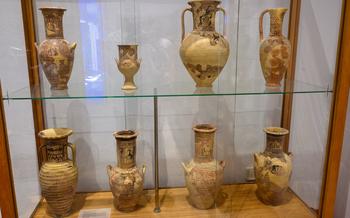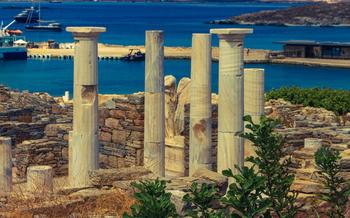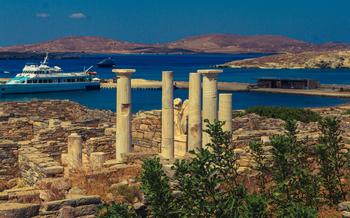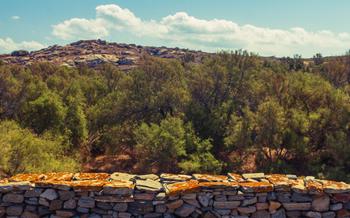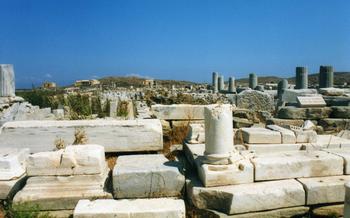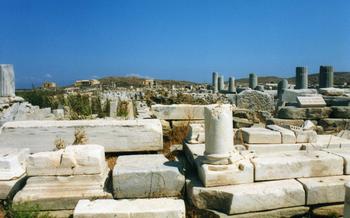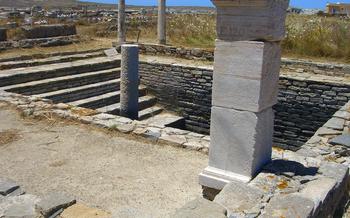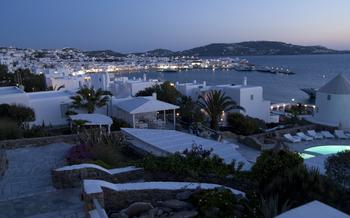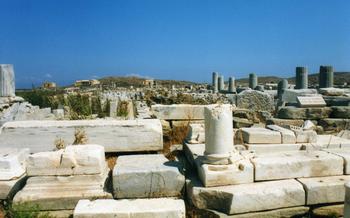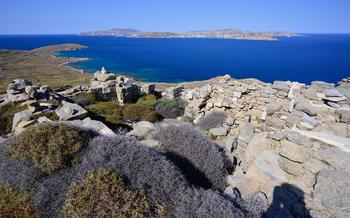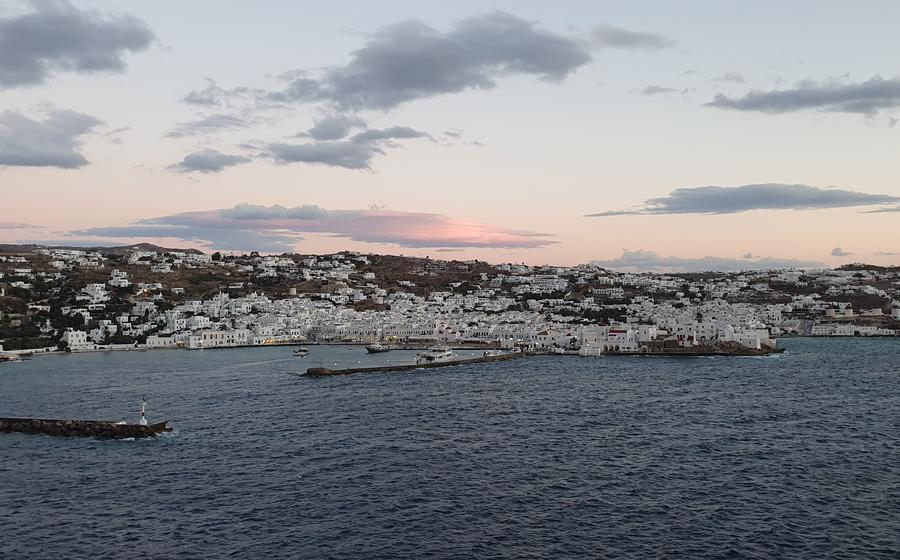
House of the Masks at Delos
- Delos: An Ancient Sanctuary Unveiled
- Journey to Delos
- The House of the Masks: A Masterpiece of Hellenistic Art
- Exploring the Archaeological Treasures of Delos
- The Sacred Way: A Path of Pilgrimage
- The Theater of Delos: A Stage for Ancient Performances
- The Sanctuary of Artemis: A Place of Worship and Healing
- The Stoivadeion: A Monument to Dionysus
- The Agora of the Compitaliasts: A Commercial Hub
- The House of Cleopatra: A Luxurious Residence
- The Naxian Terrace: A Showcase of Ancient Art
- Delos and the Athenian Empire
- Insider Tip: Enhancing Your Delos Experience
Delos: An Ancient Sanctuary Unveiled
Delos, a small yet historically significant island located in the heart of the Aegean Sea, boasts a legacy that stretches back to the depths of antiquity. Revered as a sacred sanctuary in ancient Greek mythology, Delos was believed to be the birthplace of the twin gods Apollo and Artemis, children of Zeus and Leto. This divine lineage imbued the island with an air of sanctity, attracting pilgrims and worshippers from across the Hellenic world.
Archaeological excavations conducted on Delos have unearthed a treasure trove of ancient ruins, including temples, theaters, and marketplaces, offering a glimpse into the island's glorious past. These discoveries have transformed Delos into a renowned archaeological site, attracting scholars, historians, and travelers alike. In recognition of its exceptional cultural significance, Delos was designated as a UNESCO World Heritage Site in 1990, further solidifying its status as a must-visit destination for anyone seeking to delve into the depths of ancient Greek history.
Journey to Delos
To embark on your journey to Delos, you can set sail from the picturesque port of Mykonos. Several ferry and boat services operate regularly between the two islands, providing a convenient and scenic mode of transportation. The frequency of these services varies depending on the season, but you can expect departures throughout the day, ensuring flexibility in planning your visit.
The duration of the journey typically ranges from 30 to 45 minutes, allowing you to savor the panoramic views of the Aegean Sea and the neighboring islands. As you approach Delos, the uninhabited island unveils its pristine beauty, dotted with ancient ruins that hint at its rich historical significance.
To optimize your experience, consider visiting Delos early in the morning to avoid the midday heat and crowds. This will provide ample time to explore the island's archaeological treasures at your own pace and capture stunning photographs without the distraction of large tour groups.
Upon arrival, you will disembark at the small harbor on Delos, where you can purchase entrance tickets and inquire about guided tours. Guided tours offer a wealth of information and insights into the island's history and mythology, enhancing your understanding of this sacred site.
The House of the Masks: A Masterpiece of Hellenistic Art
Amidst the ancient ruins of Delos, the House of the Masks stands as a testament to the island's rich cultural heritage. Built in the 2nd century BC, this magnificent Hellenistic mansion is adorned with intricate mosaics, vibrant frescoes, and a collection of stunning masks that have captured the imagination of visitors for centuries.
The architectural design of the House of the Masks is a marvel in itself. Its spacious rooms and elegant courtyards reflect the refined taste of its wealthy owners. The house's exterior is adorned with intricate carvings and sculptures, hinting at the treasures that lie within.
Step inside, and you'll be greeted by a breathtaking collection of masks. These theatrical masks, crafted with exquisite detail, represent a wide range of emotions and characters. From smiling comedians to tragic heroes, each mask tells a story, inviting visitors to delve into the world of ancient Greek theater.
The house's interior is further embellished with vibrant frescoes and mosaics. These colorful artworks depict scenes from mythology, nature, and everyday life, offering a glimpse into the artistic traditions of the Hellenistic period. The vibrant colors and intricate details of these artworks bring the ancient world to life, creating a truly immersive experience for visitors.
The history and legends surrounding the House of the Masks add to its allure. It is believed that the house was once owned by a wealthy merchant or a high-ranking official who had a passion for theater and the arts. Some legends suggest that the masks were used in religious rituals or theatrical performances, while others claim that they were simply decorative elements that showcased the owner's wealth and sophistication.
Today, the House of the Masks stands as a testament to the artistic achievements of the ancient Greeks. Its stunning collection of masks and vibrant frescoes offer a glimpse into the world of Hellenistic art and culture, making it a must-see attraction for anyone visiting the island of Delos.
Exploring the Archaeological Treasures of Delos
The island of Delos is a treasure trove of ancient ruins and archaeological wonders. Among the most notable sites are the Terrace of the Lions, the Sanctuary of Apollo, the Agora of the Italians, and the Theater of Delos.
The Terrace of the Lions is a particularly impressive sight. It features a row of seven majestic marble lions, each weighing over 1,000 pounds. The lions were originally placed on the terrace to guard the sacred precinct of Apollo.
The Sanctuary of Apollo is the heart of Delos' religious significance. It is home to the Temple of Apollo, which was one of the most important temples in the ancient world. The temple was dedicated to Apollo, the god of music, poetry, and prophecy.
The Agora of the Italians was a bustling marketplace in ancient times. It was located near the harbor and was a popular spot for traders from all over the Mediterranean. The agora is now a well-preserved archaeological site, with many of the original shops and stalls still visible.
The Theater of Delos is a large and well-preserved theater that was used for performances and public gatherings. The theater has a seating capacity of over 5,000 people and is one of the best-preserved ancient theaters in Greece.
The Sacred Way: A Path of Pilgrimage
The Sacred Way, a processional route of immense significance, held a central place in the religious life of Delos. This paved path, lined with altars, statues, and other sacred monuments, served as a passageway for pilgrims and worshippers making their way to the Sanctuary of Apollo, the heart of Delos' religious complex.
Along the Sacred Way, visitors encountered a series of landmarks and monuments that reflected the island's rich history and religious traditions. These included the Propylaea, a monumental gateway that marked the entrance to the sanctuary; the Stoa of Antigonus, a colonnaded portico that provided shelter for pilgrims; and the Naxian Terrace, a terrace adorned with statues dedicated to Apollo and other deities.
The Sacred Way played a crucial role in the performance of various rituals and ceremonies. During religious festivals, processions of pilgrims and priests would make their way along the path, carrying offerings and performing sacred rites. The route was also used for funeral processions, as the deceased were transported to their final resting places in the nearby cemetery.
The Sacred Way served as a physical and symbolic connection between the various sacred sites on Delos. It linked the Sanctuary of Apollo with other important religious landmarks, such as the Temple of Artemis, the Agora of the Italians, and the Theater of Delos, creating a sacred landscape that reflected the island's deep religious significance.
The Theater of Delos: A Stage for Ancient Performances
Delos was not only a religious center but also a thriving cultural hub. The Theater of Delos stands as a testament to the island's vibrant artistic traditions. Constructed in the 3rd century BC, this impressive theater boasts exceptional acoustics and a seating capacity of over 5,500 spectators. Its well-preserved state allows visitors to imagine the grandeur of ancient performances that once graced this stage.
The theater's design showcases remarkable architectural ingenuity. Its tiers of seating are arranged in a semicircle, ensuring optimal sightlines and acoustics for all attendees. The stage area is adorned with intricate stone carvings and reliefs, hinting at the elaborate sets that would have enhanced the theatrical productions.
In ancient times, the Theater of Delos played a pivotal role in the island's cultural life. It hosted a variety of performances, including plays, musical concerts, and dance recitals. These events provided entertainment and education to the inhabitants of Delos and visitors from across the Greek world.
The theater's repertoire encompassed works by renowned playwrights such as Sophocles, Euripides, and Aristophanes. These performances not only entertained but also served as a means of social commentary and political critique. The theater also hosted musical competitions, where talented musicians showcased their skills and competed for prestigious prizes.
Today, the Theater of Delos stands as a silent witness to the island's rich cultural heritage. Although no longer hosting live performances, it continues to captivate visitors with its architectural splendor and invites them to envision the vibrant artistic world that once flourished on this sacred island.
The Sanctuary of Artemis: A Place of Worship and Healing
The Sanctuary of Artemis, nestled amidst the ancient ruins of Delos, stands as a testament to the goddess's profound significance in Greek mythology and the island's spiritual allure. As the twin sister of Apollo, Artemis was revered as the protector of young women, childbirth, and the natural world. Her sanctuary on Delos served as a sacred haven for pilgrims seeking healing, guidance, and divine intervention.
The sanctuary's architectural grandeur reflects the importance of Artemis in ancient Greek society. Built around the 6th century BC, it encompasses a vast complex of temples, altars, and votive offerings. The main temple, dedicated to Artemis herself, showcases exquisite Doric columns and intricate sculptures that depict scenes from her life and exploits.
Within the sanctuary, rituals and ceremonies honoring Artemis were meticulously performed. Devotees flocked to the sacred site to offer prayers, sacrifices, and votive gifts, seeking her blessings and protection. Artemis was believed to possess the power to heal the sick, grant fertility to women, and protect travelers and sailors embarking on perilous journeys.
The sanctuary also served as a place of refuge and healing for those seeking solace and rejuvenation. Pilgrims suffering from physical ailments or emotional distress sought Artemis's divine intervention, believing that her touch could mend their wounds and restore their spirits. The sanctuary's sacred atmosphere and proximity to the healing waters of the nearby lake were thought to possess therapeutic properties, attracting individuals from far and wide.
Today, the Sanctuary of Artemis stands as a poignant reminder of the deep reverence and devotion accorded to the goddess in ancient Greece. Its ruins evoke a sense of awe and tranquility, inviting visitors to contemplate the enduring power of faith and the enduring legacy of Delos as a sacred island.
The Stoivadeion: A Monument to Dionysus
Amidst the sacred ruins of Delos, stands the Stoivadeion, a monument that pays homage to the exuberant god of wine, Dionysus. Erected in the 3rd century BC, this enigmatic structure holds a significant place in the island's cultural and religious landscape.
The Stoivadeion is believed to have been a sacred precinct dedicated to the worship of Dionysus, the deity associated with revelry, theater, and the transformative power of wine. Its architectural features mirror the grandeur of its divine patron, showcasing a blend of elegance and opulence.
The monument comprises a series of interconnected chambers and courtyards, each adorned with intricate carvings and vibrant frescoes that depict scenes from Dionysian mythology and rituals. The central courtyard, the heart of the Stoivadeion, features a striking mosaic depicting Dionysus surrounded by his entourage of satyrs and maenads, engaged in a lively dance.
The Stoivadeion's design reflects the dual nature of Dionysus, embodying both his joyous and mystical aspects. The monument served as a venue for religious ceremonies, theatrical performances, and ecstatic celebrations honoring the god. It is believed that the Stoivadeion played a pivotal role in the annual Dionysian festivals, which attracted pilgrims and revelers from across the ancient world.
Today, the Stoivadeion stands as a testament to the enduring legacy of Dionysus and the vibrant religious traditions that once flourished on Delos. Its ruins evoke the spirit of ancient festivities, inviting visitors to immerse themselves in the intoxicating atmosphere of Dionysian worship and revelry.
The Agora of the Compitaliasts: A Commercial Hub
Amidst the sacred ruins of Delos, the Agora of the Compitaliasts stands as a testament to the island's vibrant commercial past. This ancient marketplace, dating back to the 2nd century BC, served as a bustling hub where merchants from across the Mediterranean gathered to trade their wares.
The agora's central location, just a short walk from the harbor, made it easily accessible to both locals and visitors. Its spacious courtyard, surrounded by a colonnade of Doric columns, provided ample space for merchants to display their goods and customers to browse and haggle.
The Agora of the Compitaliasts was not just a place of commerce but also a social gathering spot. Here, people from different cultures and backgrounds came together to exchange not only goods but also ideas and stories. The agora's lively atmosphere was further enhanced by the presence of taverns, restaurants, and other amenities that catered to the needs of traders and travelers.
Archaeological excavations have revealed a wealth of artifacts within the agora, including coins, pottery fragments, and inscriptions. These findings shed light on the types of goods that were traded in Delos, including ceramics, textiles, spices, and luxury items such as jewelry and perfumes.
The Agora of the Compitaliasts played a crucial role in the economic development of Delos. It served as a vital link between the island and the wider Mediterranean world, facilitating the exchange of goods and ideas that contributed to the prosperity and cultural flourishing of the ancient city.
The House of Cleopatra: A Luxurious Residence
Amidst the ancient ruins of Delos, the House of Cleopatra stands as a testament to the grandeur and opulence of the Ptolemaic dynasty. Built in the 2nd century BC, this magnificent residence offers a glimpse into the luxurious lifestyle of Cleopatra VII, the last pharaoh of ancient Egypt.
The House of Cleopatra is a sprawling complex that encompasses multiple rooms, each adorned with intricate frescoes, mosaics, and marble sculptures. The walls are adorned with scenes depicting the life and reign of Cleopatra, showcasing her beauty, power, and influence. The floors are covered in intricate mosaics that depict mythological figures and geometric patterns.
One of the most striking features of the House of Cleopatra is its grand reception hall. This spacious room is supported by elegant columns and features a stunning mosaic floor that depicts a procession of Dionysus, the god of wine. The walls are lined with niches that once housed statues of Cleopatra and her ancestors.
Another highlight of the House of Cleopatra is its private chambers. These rooms are adorned with frescoes that depict scenes from Cleopatra's life, including her meeting with Julius Caesar and her triumphant return to Egypt. The chambers also feature a private bath, a dressing room, and a dining room, all of which are decorated with exquisite frescoes and mosaics.
The House of Cleopatra is a testament to the wealth and power of the Ptolemaic dynasty. This luxurious residence offers a glimpse into the life of one of the most famous women in history, Cleopatra VII, and serves as a reminder of the grandeur and opulence of ancient Egypt.
The Naxian Terrace: A Showcase of Ancient Art
The Naxian Terrace stands as a testament to the artistic prowess and cultural significance of ancient Greece. Constructed in the 6th century BC, this terrace was a sacred space dedicated to Apollo, the patron deity of Delos. The terrace's most striking feature is its collection of statues and sculptures, which once adorned the sanctuary and served as offerings to the god.
Among the most notable sculptures on the Naxian Terrace is the colossal Kouros of Apollo, a monumental statue that stands over 10 feet tall. Carved from a single block of marble, the Kouros exudes an aura of strength and majesty, embodying the divine power of Apollo. Other notable sculptures include the Naxian Sphinx, a mythical creature with the body of a lion and the head of a woman, and a series of archaic female figures known as the Korai, which represent young women in various stages of dress and adornment.
The Naxian Terrace is not merely a collection of sculptures; it is a carefully curated ensemble that reflects the religious and cultural beliefs of ancient Greece. The arrangement of the statues, their orientation towards the sanctuary, and their symbolic attributes all contribute to the terrace's sacred significance. It served as a place of worship, a backdrop for religious ceremonies, and a testament to the enduring legacy of Apollo and the rich artistic heritage of Delos.
Delos and the Athenian Empire
The island of Delos played a crucial role in the rise and fall of the Athenian Empire. Located in the heart of the Aegean Sea, Delos held strategic importance as a trading hub and a religious center. During the 5th century BC, Athens established the Delian League, a confederacy of Greek city-states formed to counter the threat of the Persian Empire. Delos served as the league's treasury, where member states contributed funds to finance military campaigns.
The Delian League transformed Delos into a bustling commercial center, attracting merchants and traders from across the Mediterranean. The island's central sanctuary of Apollo became a site of religious festivals and rituals, drawing pilgrims from far and wide. Delos' prosperity and influence reached its peak during the reign of Pericles, the Athenian statesman who oversaw the construction of magnificent temples and monuments on the island.
However, the Peloponnesian War, fought between Athens and Sparta, marked a turning point in Delos' fortunes. The war's devastation and the rise of Sparta led to the decline of the Delian League and the waning of Delos' power. The island gradually lost its commercial and religious significance, becoming a mere shadow of its former glory.
Despite its decline, Delos remained a symbol of Athenian power and influence. Its ruins and artifacts stand as a testament to the island's rich history and its role in shaping the course of ancient Greece.
Insider Tip: Enhancing Your Delos Experience
To fully immerse yourself in the magic of Delos, consider visiting during the shoulder seasons (April-May and September-October) when the weather is delightful, and the crowds are smaller. This allows you to explore the ancient ruins at your own pace, soak in the tranquility of the island, and capture stunning photographs without the distraction of throngs of tourists.
Make the most of your time on Delos by arriving early in the morning to beat the heat and the crowds. This will give you ample opportunity to wander through the archaeological site, marvel at the ancient artifacts, and take a leisurely lunch break before the afternoon rush.
Pack comfortable walking shoes as you'll be doing a lot of exploring on uneven terrain. Don't forget your hat, sunglasses, and sunscreen to protect yourself from the intense Mediterranean sun. Bring along plenty of water to stay hydrated, as there are limited refreshment options on the island.
Remember, Delos is a UNESCO World Heritage Site, so it's crucial to respect its historical significance and fragile artifacts. Refrain from touching or climbing on the ruins, and dispose of any trash responsibly to preserve the pristine beauty of this ancient sanctuary.
By following these insider tips, you'll enhance your Delos experience, creating lasting memories of your journey through this captivating island steeped in myth, history, and archaeological wonders.
